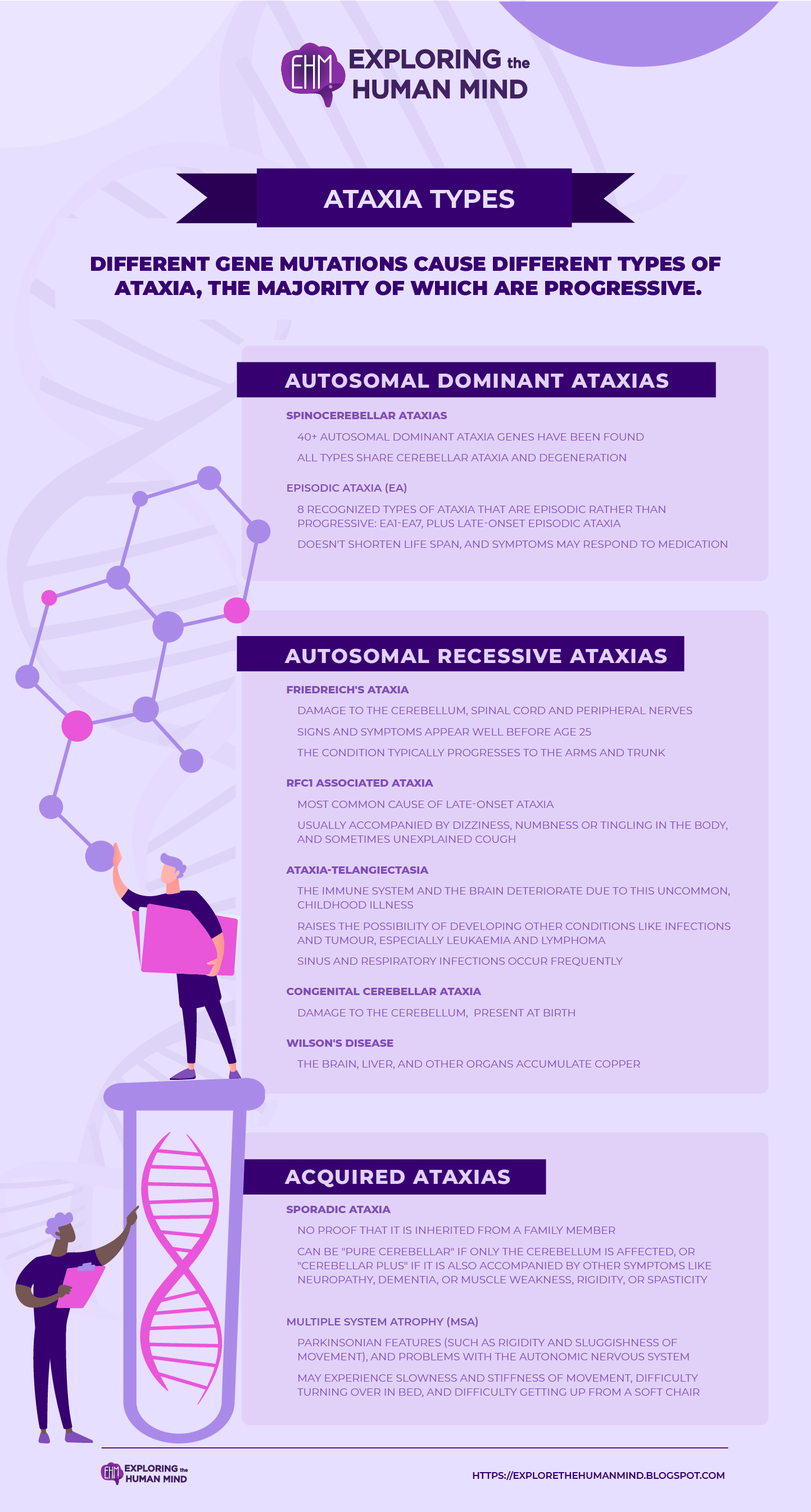Ataxia Types
Different gene mutations cause different types of ataxia, the majority of which are progressive. Each type causes poor coordination, but each has distinct signs and symptoms.
Autosomal dominant ataxias
Each child of a parent who carries an autosomal dominant Ataxia gene has a 50% chance of inheriting it. Because the gene is dominant, if a gene is passed down from one parent to the child, the child will develop the disease. Men and women are equally affected.
- Spinocerebellar ataxias. More than 40 autosomal dominant ataxia genes have been found, and the number is still increasing. All types share cerebellar ataxia and degeneration, and there could be additional neurological symptoms.
- Episodic ataxia (EA). There are eight recognized types of ataxia that are episodic rather than progressive — EA1 through EA7, plus late-onset episodic ataxia. EA1 and EA2 are the most common. EA1 involves brief ataxic episodes that may last seconds or minutes, EA2 involves longer episodes, usually lasting from 30 minutes to six hours. In some cases, symptoms resolve in later life. Episodic ataxia doesn't shorten life span, and symptoms may respond to medication.
Autosomal recessive ataxias
Males and females are equally affected by autosomal recessive inherited diseases, but for a child to get the condition, both parents must have the ataxia gene and pass it on to the child. Each recessive gene carrier parent's offspring has a 25% chance of inheriting the disease, a 50% chance of inheriting just one Ataxia gene and becoming a carrier, and a 25% chance of inheriting no Ataxia genes. A single recessive ataxia gene can run unnoticed in a family for generations because it does not manifest any symptoms. Therefore, if ataxia was inherited as a recessive gene, there could appear to be no "family history" of the condition.
- Friedreich's ataxia.This is the most common hereditary ataxia. It involves damage to the cerebellum, spinal cord and peripheral nerves. Peripheral nerves carry signals from the arms and legs to the brain and spinal cord. In most cases, signs and symptoms appear well before age 25. The cerebellum usually appears normal on a brain scan. The first indication generally is difficulty walking. The condition typically progresses to the arms and trunk. There are often deformities of the feet, such as high arches, and curvature of the spine (scoliosis). Early treatment of heart problems can improve quality of life and survival.
- RFC1 associated ataxia.This is the most common cause of late-onset ataxia. The ataxia symptoms are usually accompanied by dizziness, numbness or tingling in the body, and sometimes unexplained cough.
- Ataxia-telangiectasia.The immune system and the brain deteriorate due to this uncommon, childhood illness. This raises the possibility of developing other conditions like infections and tumours.Sinus and respiratory infections occur frequently. The risk of cancer in children with ataxia-telangiectasia is very high, especially leukemia and lymphoma.
- Congenital cerebellar ataxia.Damage to the cerebellum, which is present at birth, causes this kind of ataxia.
- Wilson's disease. The brain, liver, and other organs of those who have this condition accumulate copper. This may result in neurological issues such as ataxia.
Acquired Ataxias
There is a significant number of people who experience ataxia symptoms that typically start in adulthood, come "out of nowhere," and have no known family history of the condition. With acquired ataxia, there is an external cause, meaning a person experienced a life event that contributed to the development of the condition. This can cover a wide range of issues and occurrences, including lack of certain vitamins, autoimmune disorders, certain infections, exposure to harmful substances or drugs (especially alcohol), different cancers, and many others.
- Sporadic Ataxia.There is no proof that sporadic ataxia was inherited from a family member. It may be challenging to diagnose. Before a diagnosis of sporadic ataxia can be made, other forms of ataxia must be ruled out. The term "neurodegenerative" refers to the condition because there is no known cause for the gradual disappearance of the cerebellum's nerve cells over time. Sporadic ataxia can be "pure cerebellar" if only the cerebellum is affected, or it can be "cerebellar plus" if it is also accompanied by other symptoms like neuropathy, dementia, or muscle weakness, rigidity, or spasticity. When diagnosing sporadic ataxia, doctors frequently use a variety of terms. Several of these include: Olivopontocerebellar atrophy (OPCA), Olivopontocerebellar degeneration, Idiopathic late onset cerebellar atrophy or degeneration (ILOCA or ILOCD).
- Multiple System Atrophy (MSA)Sporadic ataxia symptoms can sometimes be a sign of Multiple System Atrophy (MSA), which is characterised by ataxia, Parkinsonian features (such as rigidity and sluggishness of movement), and problems with the autonomic nervous system. The autonomic nervous system is in charge of the body's automatic processes, which include blood pressure control, digestion, bladder and bowel control, some sexual functions, and sweating. People with MSA, whose symptoms start with sporadic ataxia, may experience slowness and stiffness of movement, difficulty turning over in bed, and difficulty getting up from a soft chair, all of which are Parkinsonian symptoms.

vectors by Freepick; graphic design by Vadot
Reference:
Ataxia - Symptoms and causes. (2022). Mayo Clinic; https://www.mayoclinic.org/diseases-conditions/ataxia/symptoms-causes/syc-20355652
What is Ataxia? (2023, May 25). National Ataxia Foundation. https://www.ataxia.org/what-is-ataxia/






Comments
Post a Comment